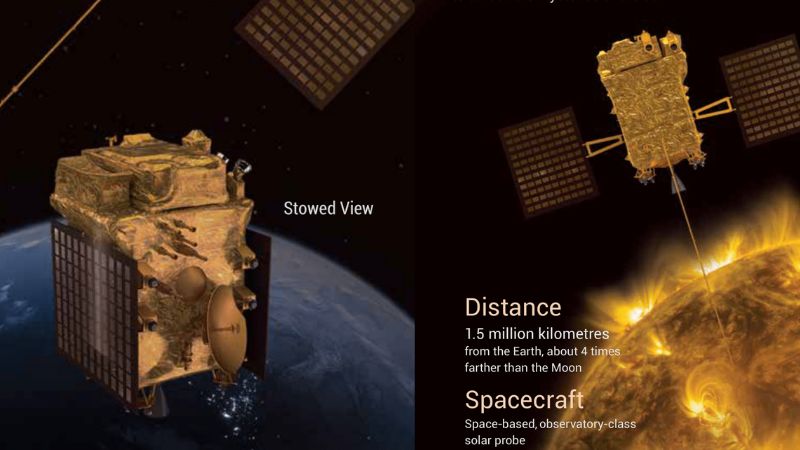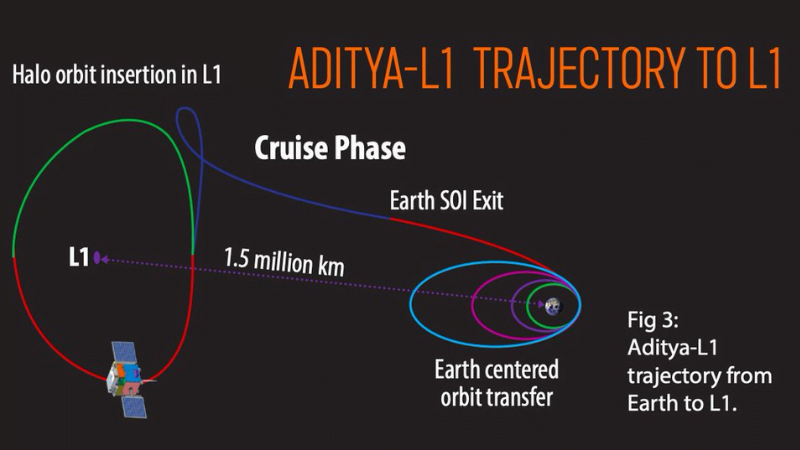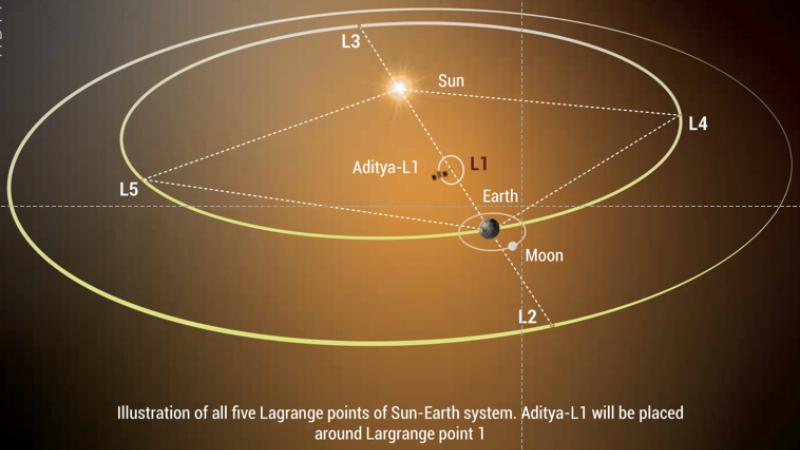Get ready to witness history in the making as we prepare for the launch of Aditya L1 India’s first solar mission for Sun, scheduled to take place on September 2, 2023! This groundbreaking mission is all set to shed light on our closest star, the Sun, and promises to unveil secrets hidden in its fiery depths.
Table of Contents
A Journey of Cosmic Proportions
Aditya L1 will embark on an extraordinary journey, spanning approximately 1.5 million kilometers from Earth. To put it into perspective, that’s four times farther than the distance to the moon! The spacecraft will traverse this vast expanse to reach its destination – Lagrange point 1 (L1) in the Sun-Earth system. Aditya-L1 is not intended to land on the Sun or approach it closely. Instead, it will be placed in a halo orbit around Lagrange point L1, which is about 1.5 million kilometers away from the Earth. This strategic orbit allows Aditya-L1 to continuously observe the Sun without getting too close, ensuring the safety of the spacecraft while still providing valuable data about the Sun’s activities and behavior.
When and Where Will Aditya L1 Launch?
The much-anticipated launch of Aditya L1 is set for September 2, 2023. The countdown will begin at 11:50 A.M. IST (Indian Standard Time) from Sriharikota, a picturesque island off the eastern coast of India. It’s a momentous occasion that will mark India’s first dedicated solar mission.
Cutting-Edge Technology at the Helm
This cosmic voyage is made possible by cutting-edge technology, and one star player is the Liquid Apogee Motor (LAM) engine, developed by the Liquid Propulsion Systems Centre (LPSC). The LAM engine will orchestrate vital orbital adjustments to position Aditya L1 precisely at L1, a feat that showcases India’s prowess in space technology.

Aditya-L1 Payloads: Unveiling the Sun’s Secrets
Aditya-L1, India’s first dedicated solar mission, is a marvel of scientific instrumentation. With seven payloads on board, this mission is equipped to unravel the mysteries of the Sun like never before. Let’s take a closer look at these payloads and how they will revolutionize our understanding of the solar atmosphere and the local environment at Lagrange point L1:
Remote Sensing of the Sun’s Atmosphere:
1. Visible Emission Line Coronagraph (VELC): This payload is like a cosmic detective, focused on studying the solar corona and inner heliosphere. By capturing visible emission lines, VELC will provide invaluable insights into the Sun’s outer atmosphere and its dynamic behavior.
2. Solar Ultraviolet Imaging Telescope (SUIT): Imagine a high-definition camera for the Sun. SUIT’s mission is to observe the photosphere and chromosphere of the Sun in both narrow and broad bands. It will offer detailed images and data to help us comprehend the Sun’s surface and the layer just above it.
3. Solar Low Energy X-ray Spectrometer (SoLEXS): Going beyond what our eyes can see, SoLEXS will study soft X-rays emitted by the Sun. These X-rays contain crucial information about the Sun’s inner workings and will contribute to a comprehensive understanding of solar activity.
4. High Energy L1 Orbiting X-ray Spectrometer (HEL1OS): HEL1OS takes it up a notch by focusing on hard X-rays emitted by the Sun. This payload will explore the high-energy side of solar phenomena, enhancing our knowledge of solar flares and other high-energy events.

In-Situ Observations:
5. Aditya Solar wind Particle Experiment (ASPEX): ASPEX is like a cosmic particle hunter, analyzing solar wind and particles, including protons and heavier ions. By understanding the characteristics and directions of these particles, we gain insights into the solar environment.
6. Plasma Analyser Package For Aditya (PAPA): PAPA is a specialist in analyzing solar wind and particles, but it focuses on electrons and heavier ions. Together with ASPEX, it provides a complete picture of the solar wind and its dynamics.
In-Situ Magnetic Field Study:
7. Advanced Tri-axial High-Resolution Digital Magnetometers: This payload is like a compass in space, dedicated to studying the in-situ magnetic field around Aditya-L1. Magnetic fields play a fundamental role in solar activity, and understanding them is essential for predicting space weather.
With these seven payloads on board, Aditya-L1 is poised to transform our understanding of the Sun’s atmosphere and the environment at Lagrange point L1. It’s a mission that combines remote sensing and in-situ observations to provide a comprehensive view of our closest star.
Aditya-L1 Mission: Four Unique Advancements in Solar Exploration
When it comes to exploring the Sun, the first question that arises is how it is different from the previous solar missions launched by other countries’ space agencies. Aditya-L1 mission, India’s first dedicated solar expedition, brings four distinct innovations to the table that have never been attempted in any other space mission by any country. Let’s dive into what makes Aditya-L1 truly unique:
1. Spatially Resolved Solar Disk in Near UV Band
Aditya-L1 boasts the remarkable capability to provide spatially resolved images of the solar disk in the near UV (ultraviolet) band. While many solar missions have captured the Sun’s beauty in various wavelengths, this is the first time we will be able to see the Sun’s surface in such fine detail in the near UV band. This breakthrough allows scientists to study the Sun’s surface features and dynamics in an entirely new light.
2. Close-Up Study of CME Dynamics
Coronal Mass Ejections (CMEs) are powerful eruptions of solar material that can impact space weather and our technology on Earth. Aditya L1 will observe CME dynamics from an exceptionally close range, at a distance of approximately 1.05 solar radii from the Sun’s surface. This proximity provides a unique vantage point to investigate the acceleration of CMEs, a crucial phase that has remained largely unobserved in a consistent manner. Understanding CME acceleration is a key piece of the puzzle for space weather prediction.
3. Onboard Intelligence for Solar Events
Aditya L1 isn’t just a passive observer; it comes equipped with onboard intelligence. This intelligent system is designed to detect CMEs and solar flares autonomously. When it identifies these solar events, it optimizes the spacecraft’s observations and data volume, ensuring that we capture the most critical moments. This real-time detection capability enhances the mission’s responsiveness and the quality of its observations.

4. Comprehensive Solar Wind Analysis
The spacecraft is equipped to capture the directional and energy anisotropy of solar wind through multi-directional observations. Solar wind, a stream of charged particles from the Sun, can have varying properties in different directions and energy states. Aditya L1’s comprehensive analysis of solar wind will provide scientists with a deeper understanding of these dynamic variations, shedding light on how solar wind interacts with our planet and its magnetosphere.
Aditya L1 is a mission of firsts and innovations. It’s pushing the boundaries of solar exploration, offering new perspectives on the Sun’s surface, CME dynamics, real-time event detection, and solar wind properties.
What is the cost of the Aditya L-1 mission
The Aditya L-1 mission is expected to have an estimated cost of around Rs 400 crore. Although the Indian government initially allocated a budget of Rs 378 crore for the mission, comprehensive budget details have not been officially disclosed by ISRO. This mission represents a significant investment in solar research and holds the promise of advancing our understanding of the Sun and its impact on Earth and space weather.
The Global Impact of Aditya L1 Mission
Aditya L1 is not just a mission for India; it’s a mission for all of humanity. The Aditya-L1 mission is gearing up to deliver a staggering 1,440 images per day, according to statements from key scientists. This influx of data promises to revolutionize our understanding of the Sun and its dynamic behavior. The data and knowledge it generates will contribute to our global understanding of the Sun and its influence on our world. The information gathered will aid in the development of technologies and strategies to safeguard our satellites, power grids, and communication systems from solar disturbances.
Watch Aditya-L1 Launch Live:
You can catch the live broadcast of the launch Aditya-L1 on various platforms:
- ISRO Website: Visit ISRO’s official website for live coverage and updates on the Aditya-L1 launch.
- Facebook: Tune in to ISRO’s official Facebook page at https://facebook.com/ISRO for a live stream of the launch.
- YouTube: You can also watch the live launch on ISRO’s official YouTube channel at https://youtube.com/watch?v=_IcgGYZTXQw.
Stay Tuned for Updates
As Aditya L1 embarks on its mission to unlock the Sun’s secrets, we invite you to stay tuned for regular updates. Follow this celestial journey closely, for it promises to reshape our understanding of the Sun and its profound influence on Earth and the universe.
Tomorrow, on September 2, 2023, as the clock strikes 11:50 A.M. IST, history will be made as Aditya L1 sets out on its epic journey. Our star, the Sun, is about to reveal its hidden treasures, and we are all privileged witnesses to this cosmic spectacle.
Let the countdown begin as Aditya L1 takes flight, embarking on an epic voyage of discovery. Together, we will journey near the very heart of our Solar System and uncover the marvels of the universe.
Read More: Aditya L1 Launch Soars To The Skies: India’s Remarkable Solar Mission Takes Flight
Read More: Solar Storm In 2023: Are We Headed For An Internet Apocalypse ?
Read More: Anticipation Soars As UEFA Champions League 2023-24 Group Stage Draw Unveils Thrilling Fixtures
Read More: 13 Must-Have Thought Revolution Books: Elevating Your Success Mindset
Read More: Breaking Down The Bitcoin Price Drop 2023: What’s Behind The Sudden Price Fall?
Read More: Top 10 Kitchen Gadgets On Amazon In 2023! Every Kitchen Chef Must Have!
Read More: Solar Storm In 2023: Are We Headed For An Internet Apocalypse ?






